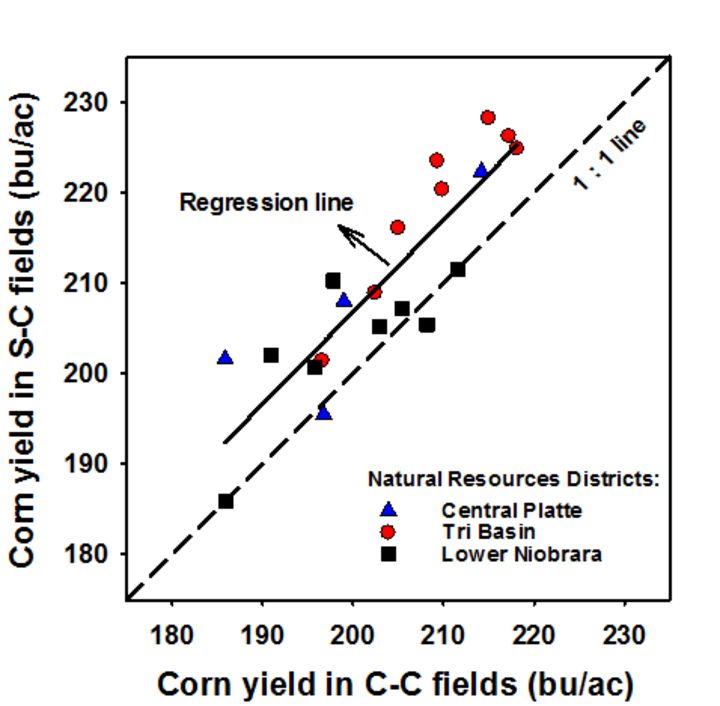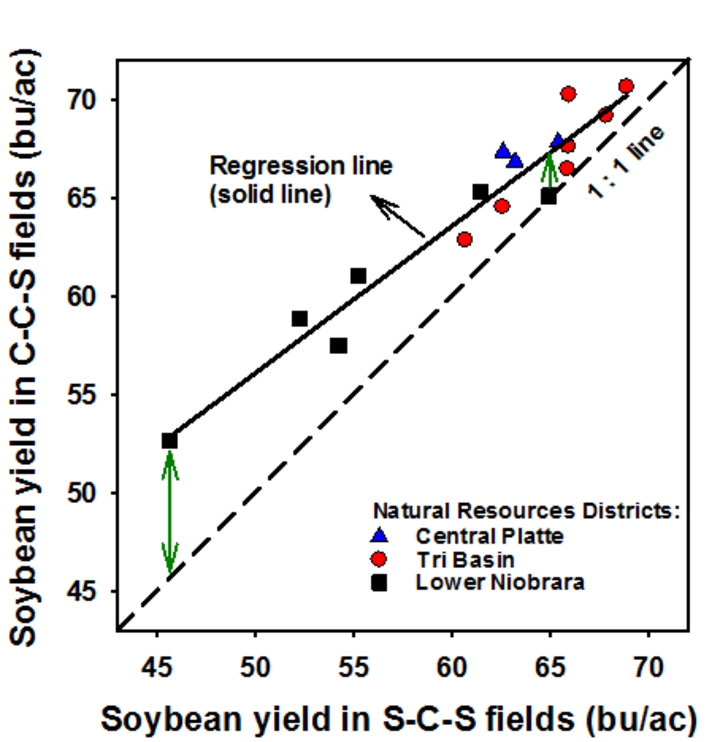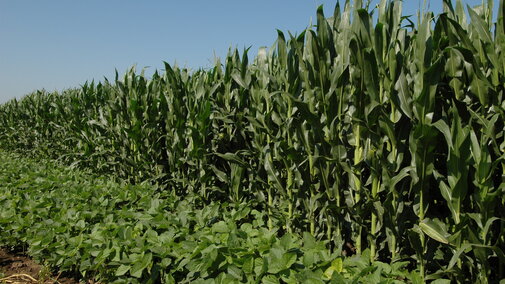On most Nebraska rainfed farms, soybean and corn are usually rotated. On irrigated fields, however, the rotation sequence tends to shift to more years of corn between soybean, and in some cases, corn is grown continuously, year-after-year.
Effect of Crop Sequence on Corn Yields
In Figure 1 the left axis is corn yield in a soybean-corn (S-C) rotation, whereas the bottom axis is corn yield after a prior year of corn (C-C). The colored symbols denote the yields of corn in hundreds of irrigated fields surveyed in three Natural Resources Districts (Central Platte, Tri-Basin, and Lower Niobrara) from 2006 to 2013. Each data point is a year in a particular NRD. These data were collected in a project funded by the Nebraska Corn Board. The dashed 1:1 line denotes equality in yield if corn is not impacted by a prior year’s crop. However, the chart’s solid line shows that, on average, actual corn yield was indeed impacted. Corn yield was 7 bu/ac higher when following soybean than when following corn across the low-to-high (190-220 bu/ac) irrigated yield range.


Using the same survey data, only a negligible 1 bu/ac corn yield advantage was detected when corn was grown in the third year of an S-C-C sequence versus the third year of a C-C-C sequence (Figure 2). Thus, the 7 bu/ac boost in corn yield following soybean almost disappears if soybean is not the prior year crop. Keep in mind that in an S-C-S-C rotation, the corn yield boost occurred despite a lower N fertilization of corn. In fact, our survey data indicate that, on average, Nebraska farmers apply 12 lb/ac less N fertilizer in corn after soybean relative to corn after corn, because of the N credit applicable in corn following soybean. (See Table 10-2 on page 76 in the Nebraska Extension publication, Nutrient Management for Agronomic Crops in Nebraska, EC155.)
Effect of Crop Sequence on Soybean Yields
Soybean yield was higher following two prior years of corn (C-C-S) compared to just one prior year of corn (S-C-S) (Figure 3). However, the solid line did not parallel the 1:1 line, thus revealing that the yield advantage diminished in more productive fields. For example, soybean yields were 52 bu/ac for C-C-S versus 45 bu/ac for S-C-S (lower left green arrow), but just 67 bu/ac versus 65 bu/ac (upper right green arrow). The reason for this is not clear, though the yield bump was greater in the Lower Niobrara NRD. These data suggest that if in a given year the corn/soy price ratio favors increasing your irrigated soybean acreage, you might want to interrupt a long C-C-C-etc. sequence with a soybean crop to take advantage of the soybean yield boost as well as the favorable price.
How about yields of soybean following a prior soybean crop? A continuous soybean system is rarely practiced nowadays in the Corn Belt. Data collected from long-term experiments show that soybean following corn in a two-year corn-soybean rotation out yields soybean in a continuous soybean sequence by 5% to 15% as summarized by Fox et al., 2013 (Estimating Soybean Genetic Gain for Yield in the Northern United States—Influence of Cropping History, Agronomy Journal 53: 2473-2482;). This is consistent with recent data reported by University of Wisconsin researchers (Grower News: The Facts about Growing Second Year Soybeans).

Conclusions
Corn and soybean will invariably yield more when they are part of an annual soybean-corn rotation (C-S) than when they are grown continuously (C-C or S-S). Soybean also yields more after two prior years of corn, compared to one prior year of corn.
In addition to the yield benefit, crop rotation also offers benefits as part of an integrated pest management strategy to reduce reliance on a single pesticide mode of action for a single crop and to help break weed, insect, and disease cycles.

